Contemporary Healthcare Influences on Nursing Practice in Australia
VerifiedAdded on 2023/06/10
|7
|1980
|256
Essay
AI Summary
This essay, written for the 1803NRS Foundations of Professional Nursing course, explores the significant influences that have shaped the Australian healthcare system and the role of Registered Nurses (RNs). The introduction sets the context by defining nursing practice and its core components, including promoting well-being, preventing illness, restoring health, and caring for the dying. The main body of the essay identifies and describes two key influences on contemporary Australian healthcare: the impact of individual lifestyle choices (e.g., smoking, diet) and the social determinants of health. It then discusses how these influences have shaped access to healthcare, highlighting inequalities and disparities. The essay further analyzes how each influence impacts the role of the RN, emphasizing the importance of addressing social determinants through inter-sectoral collaboration and public advocacy. The conclusion summarizes the key findings and reinforces the significance of understanding these influences for effective nursing practice in Australia. References are provided to support the arguments presented.
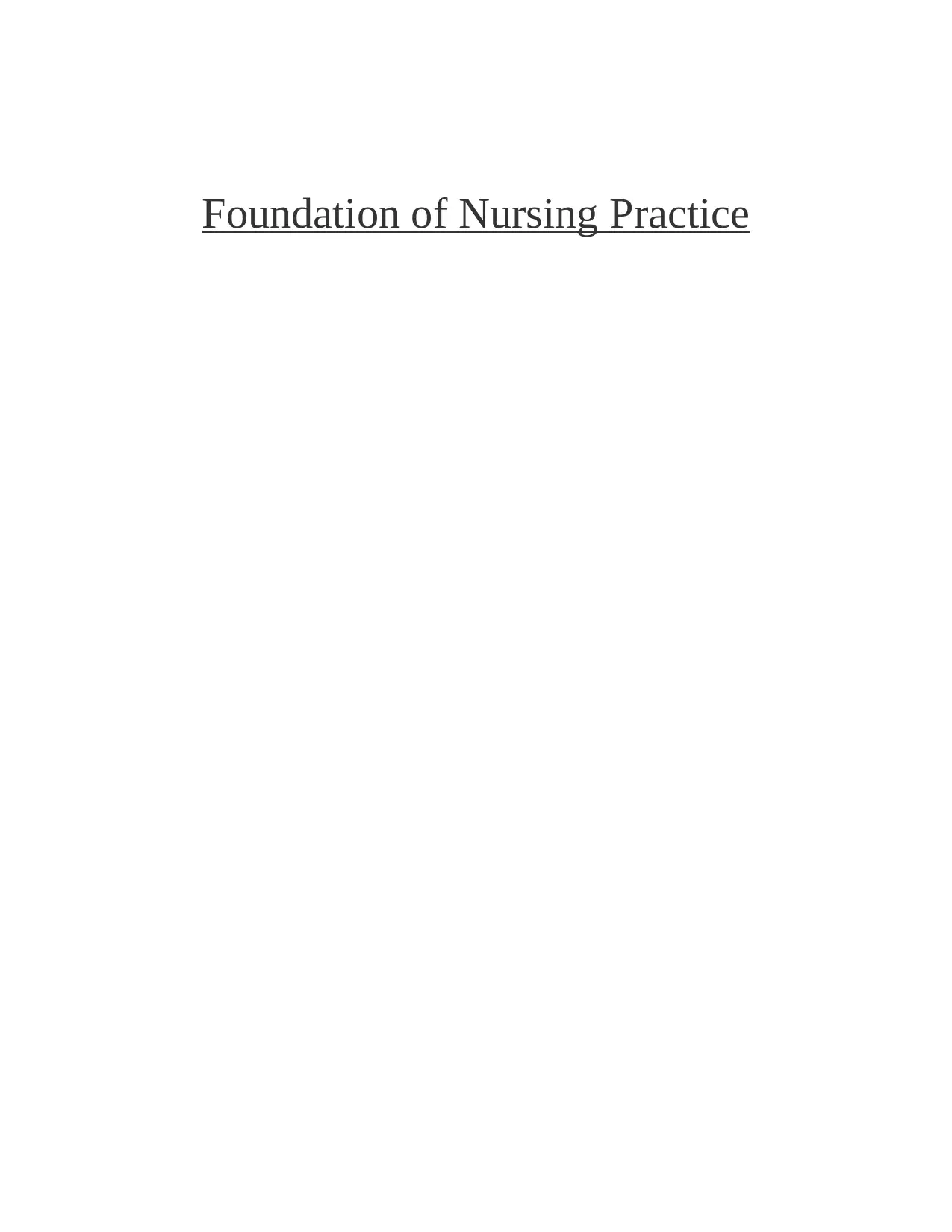
Foundation of Nursing Practice
Paraphrase This Document
Need a fresh take? Get an instant paraphrase of this document with our AI Paraphraser
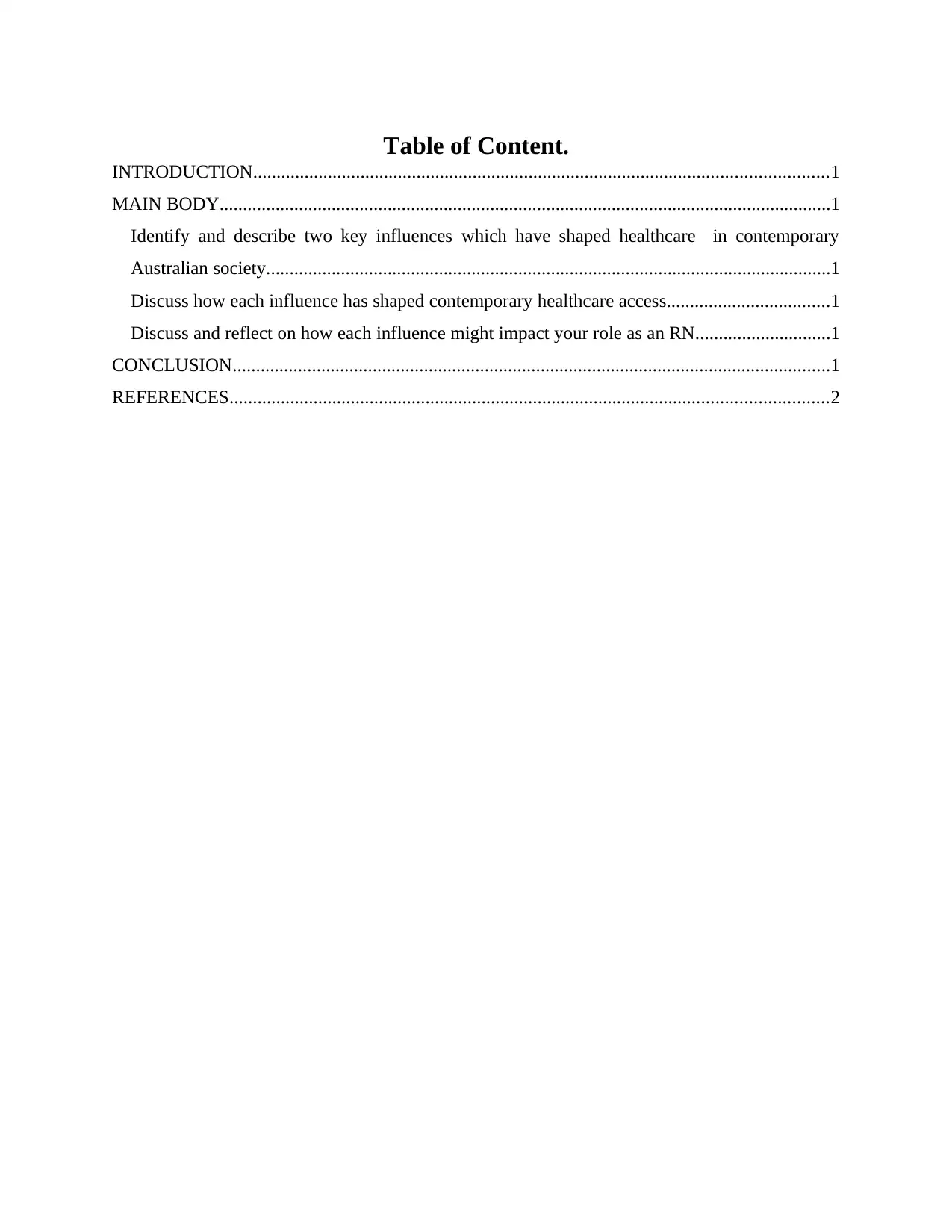
Table of Content.
INTRODUCTION...........................................................................................................................1
MAIN BODY...................................................................................................................................1
Identify and describe two key influences which have shaped healthcare in contemporary
Australian society.........................................................................................................................1
Discuss how each influence has shaped contemporary healthcare access...................................1
Discuss and reflect on how each influence might impact your role as an RN.............................1
CONCLUSION................................................................................................................................1
REFERENCES................................................................................................................................2
INTRODUCTION...........................................................................................................................1
MAIN BODY...................................................................................................................................1
Identify and describe two key influences which have shaped healthcare in contemporary
Australian society.........................................................................................................................1
Discuss how each influence has shaped contemporary healthcare access...................................1
Discuss and reflect on how each influence might impact your role as an RN.............................1
CONCLUSION................................................................................................................................1
REFERENCES................................................................................................................................2
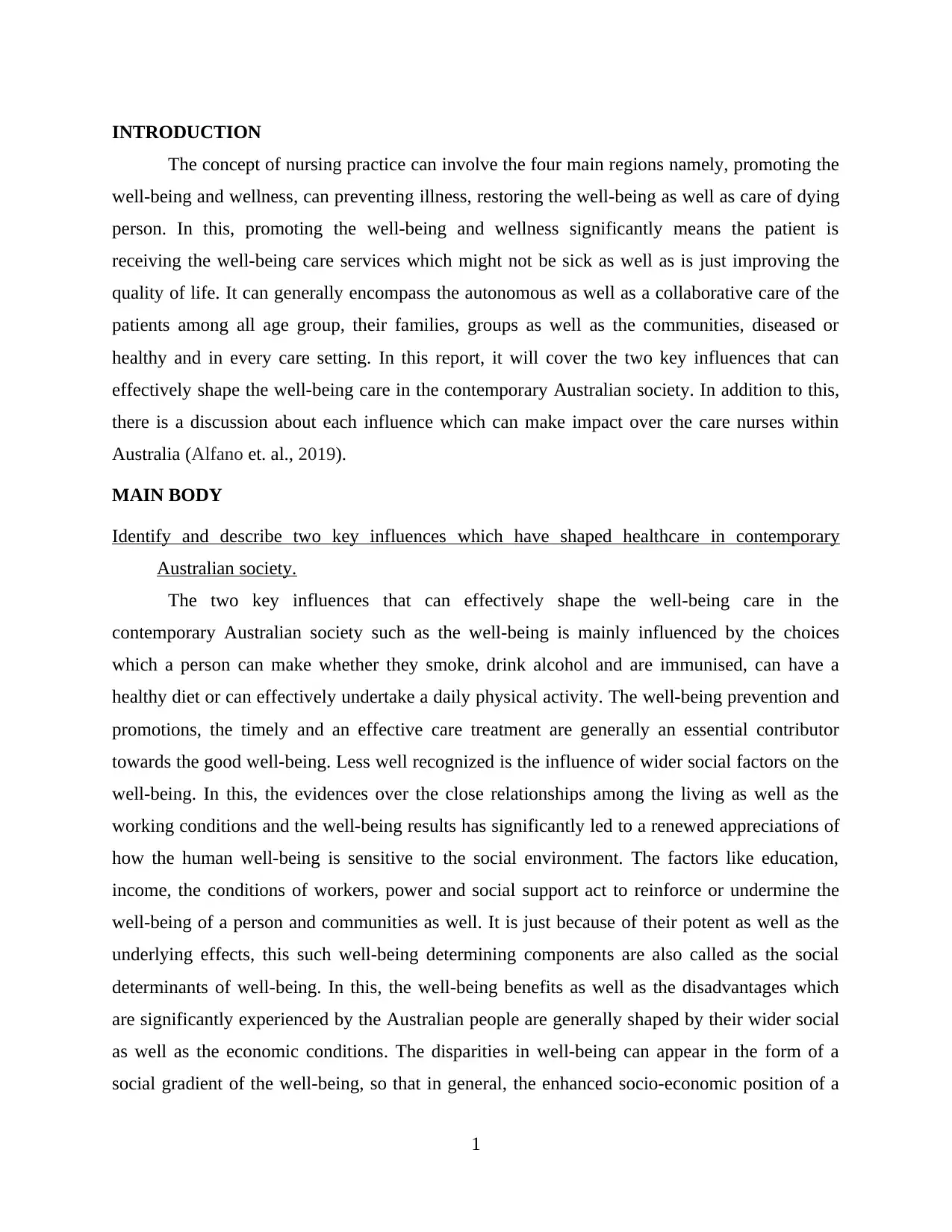
INTRODUCTION
The concept of nursing practice can involve the four main regions namely, promoting the
well-being and wellness, can preventing illness, restoring the well-being as well as care of dying
person. In this, promoting the well-being and wellness significantly means the patient is
receiving the well-being care services which might not be sick as well as is just improving the
quality of life. It can generally encompass the autonomous as well as a collaborative care of the
patients among all age group, their families, groups as well as the communities, diseased or
healthy and in every care setting. In this report, it will cover the two key influences that can
effectively shape the well-being care in the contemporary Australian society. In addition to this,
there is a discussion about each influence which can make impact over the care nurses within
Australia (Alfano et. al., 2019).
MAIN BODY
Identify and describe two key influences which have shaped healthcare in contemporary
Australian society.
The two key influences that can effectively shape the well-being care in the
contemporary Australian society such as the well-being is mainly influenced by the choices
which a person can make whether they smoke, drink alcohol and are immunised, can have a
healthy diet or can effectively undertake a daily physical activity. The well-being prevention and
promotions, the timely and an effective care treatment are generally an essential contributor
towards the good well-being. Less well recognized is the influence of wider social factors on the
well-being. In this, the evidences over the close relationships among the living as well as the
working conditions and the well-being results has significantly led to a renewed appreciations of
how the human well-being is sensitive to the social environment. The factors like education,
income, the conditions of workers, power and social support act to reinforce or undermine the
well-being of a person and communities as well. It is just because of their potent as well as the
underlying effects, this such well-being determining components are also called as the social
determinants of well-being. In this, the well-being benefits as well as the disadvantages which
are significantly experienced by the Australian people are generally shaped by their wider social
as well as the economic conditions. The disparities in well-being can appear in the form of a
social gradient of the well-being, so that in general, the enhanced socio-economic position of a
1
The concept of nursing practice can involve the four main regions namely, promoting the
well-being and wellness, can preventing illness, restoring the well-being as well as care of dying
person. In this, promoting the well-being and wellness significantly means the patient is
receiving the well-being care services which might not be sick as well as is just improving the
quality of life. It can generally encompass the autonomous as well as a collaborative care of the
patients among all age group, their families, groups as well as the communities, diseased or
healthy and in every care setting. In this report, it will cover the two key influences that can
effectively shape the well-being care in the contemporary Australian society. In addition to this,
there is a discussion about each influence which can make impact over the care nurses within
Australia (Alfano et. al., 2019).
MAIN BODY
Identify and describe two key influences which have shaped healthcare in contemporary
Australian society.
The two key influences that can effectively shape the well-being care in the
contemporary Australian society such as the well-being is mainly influenced by the choices
which a person can make whether they smoke, drink alcohol and are immunised, can have a
healthy diet or can effectively undertake a daily physical activity. The well-being prevention and
promotions, the timely and an effective care treatment are generally an essential contributor
towards the good well-being. Less well recognized is the influence of wider social factors on the
well-being. In this, the evidences over the close relationships among the living as well as the
working conditions and the well-being results has significantly led to a renewed appreciations of
how the human well-being is sensitive to the social environment. The factors like education,
income, the conditions of workers, power and social support act to reinforce or undermine the
well-being of a person and communities as well. It is just because of their potent as well as the
underlying effects, this such well-being determining components are also called as the social
determinants of well-being. In this, the well-being benefits as well as the disadvantages which
are significantly experienced by the Australian people are generally shaped by their wider social
as well as the economic conditions. The disparities in well-being can appear in the form of a
social gradient of the well-being, so that in general, the enhanced socio-economic position of a
1
⊘ This is a preview!⊘
Do you want full access?
Subscribe today to unlock all pages.

Trusted by 1+ million students worldwide
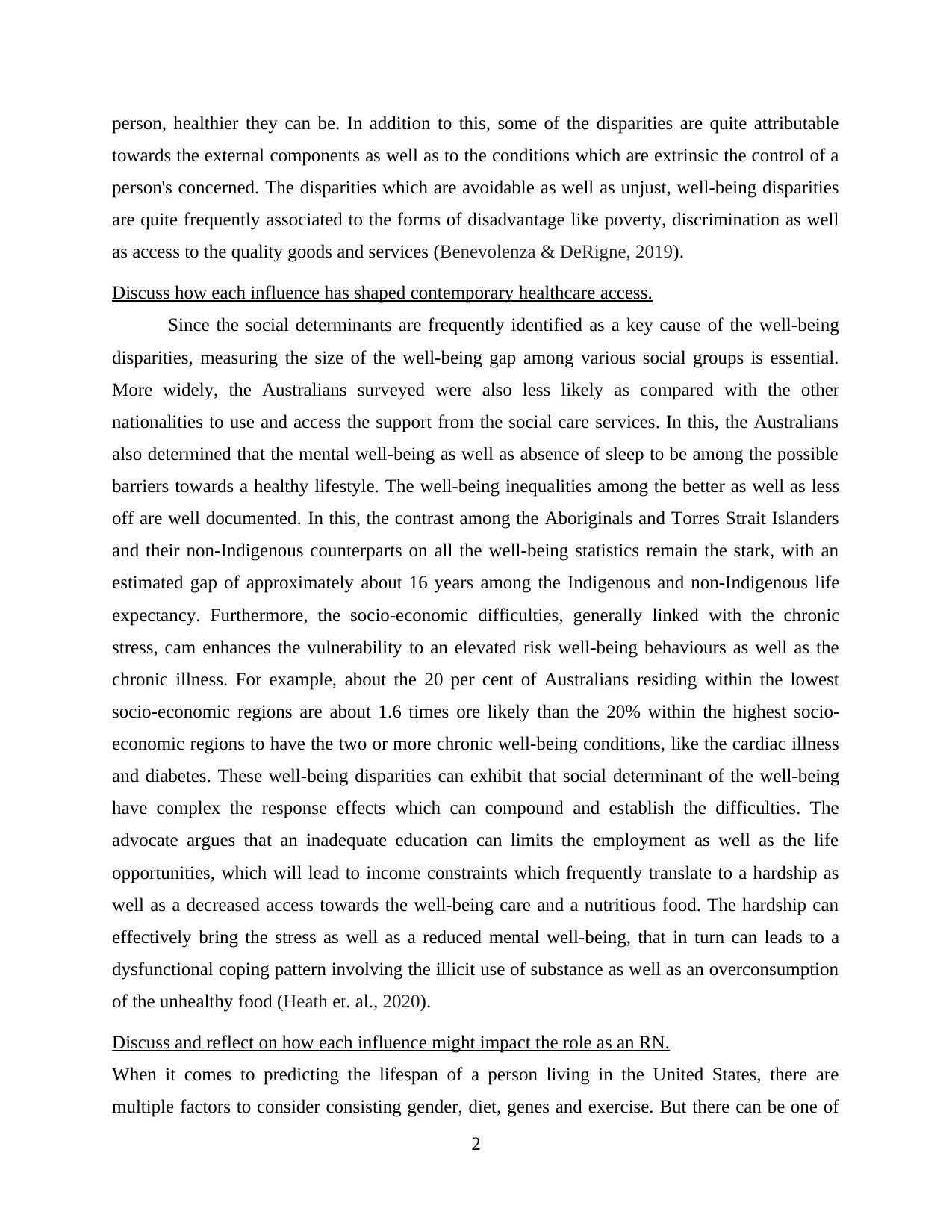
person, healthier they can be. In addition to this, some of the disparities are quite attributable
towards the external components as well as to the conditions which are extrinsic the control of a
person's concerned. The disparities which are avoidable as well as unjust, well-being disparities
are quite frequently associated to the forms of disadvantage like poverty, discrimination as well
as access to the quality goods and services (Benevolenza & DeRigne, 2019).
Discuss how each influence has shaped contemporary healthcare access.
Since the social determinants are frequently identified as a key cause of the well-being
disparities, measuring the size of the well-being gap among various social groups is essential.
More widely, the Australians surveyed were also less likely as compared with the other
nationalities to use and access the support from the social care services. In this, the Australians
also determined that the mental well-being as well as absence of sleep to be among the possible
barriers towards a healthy lifestyle. The well-being inequalities among the better as well as less
off are well documented. In this, the contrast among the Aboriginals and Torres Strait Islanders
and their non-Indigenous counterparts on all the well-being statistics remain the stark, with an
estimated gap of approximately about 16 years among the Indigenous and non-Indigenous life
expectancy. Furthermore, the socio-economic difficulties, generally linked with the chronic
stress, cam enhances the vulnerability to an elevated risk well-being behaviours as well as the
chronic illness. For example, about the 20 per cent of Australians residing within the lowest
socio-economic regions are about 1.6 times ore likely than the 20% within the highest socio-
economic regions to have the two or more chronic well-being conditions, like the cardiac illness
and diabetes. These well-being disparities can exhibit that social determinant of the well-being
have complex the response effects which can compound and establish the difficulties. The
advocate argues that an inadequate education can limits the employment as well as the life
opportunities, which will lead to income constraints which frequently translate to a hardship as
well as a decreased access towards the well-being care and a nutritious food. The hardship can
effectively bring the stress as well as a reduced mental well-being, that in turn can leads to a
dysfunctional coping pattern involving the illicit use of substance as well as an overconsumption
of the unhealthy food (Heath et. al., 2020).
Discuss and reflect on how each influence might impact the role as an RN.
When it comes to predicting the lifespan of a person living in the United States, there are
multiple factors to consider consisting gender, diet, genes and exercise. But there can be one of
2
towards the external components as well as to the conditions which are extrinsic the control of a
person's concerned. The disparities which are avoidable as well as unjust, well-being disparities
are quite frequently associated to the forms of disadvantage like poverty, discrimination as well
as access to the quality goods and services (Benevolenza & DeRigne, 2019).
Discuss how each influence has shaped contemporary healthcare access.
Since the social determinants are frequently identified as a key cause of the well-being
disparities, measuring the size of the well-being gap among various social groups is essential.
More widely, the Australians surveyed were also less likely as compared with the other
nationalities to use and access the support from the social care services. In this, the Australians
also determined that the mental well-being as well as absence of sleep to be among the possible
barriers towards a healthy lifestyle. The well-being inequalities among the better as well as less
off are well documented. In this, the contrast among the Aboriginals and Torres Strait Islanders
and their non-Indigenous counterparts on all the well-being statistics remain the stark, with an
estimated gap of approximately about 16 years among the Indigenous and non-Indigenous life
expectancy. Furthermore, the socio-economic difficulties, generally linked with the chronic
stress, cam enhances the vulnerability to an elevated risk well-being behaviours as well as the
chronic illness. For example, about the 20 per cent of Australians residing within the lowest
socio-economic regions are about 1.6 times ore likely than the 20% within the highest socio-
economic regions to have the two or more chronic well-being conditions, like the cardiac illness
and diabetes. These well-being disparities can exhibit that social determinant of the well-being
have complex the response effects which can compound and establish the difficulties. The
advocate argues that an inadequate education can limits the employment as well as the life
opportunities, which will lead to income constraints which frequently translate to a hardship as
well as a decreased access towards the well-being care and a nutritious food. The hardship can
effectively bring the stress as well as a reduced mental well-being, that in turn can leads to a
dysfunctional coping pattern involving the illicit use of substance as well as an overconsumption
of the unhealthy food (Heath et. al., 2020).
Discuss and reflect on how each influence might impact the role as an RN.
When it comes to predicting the lifespan of a person living in the United States, there are
multiple factors to consider consisting gender, diet, genes and exercise. But there can be one of
2
Paraphrase This Document
Need a fresh take? Get an instant paraphrase of this document with our AI Paraphraser
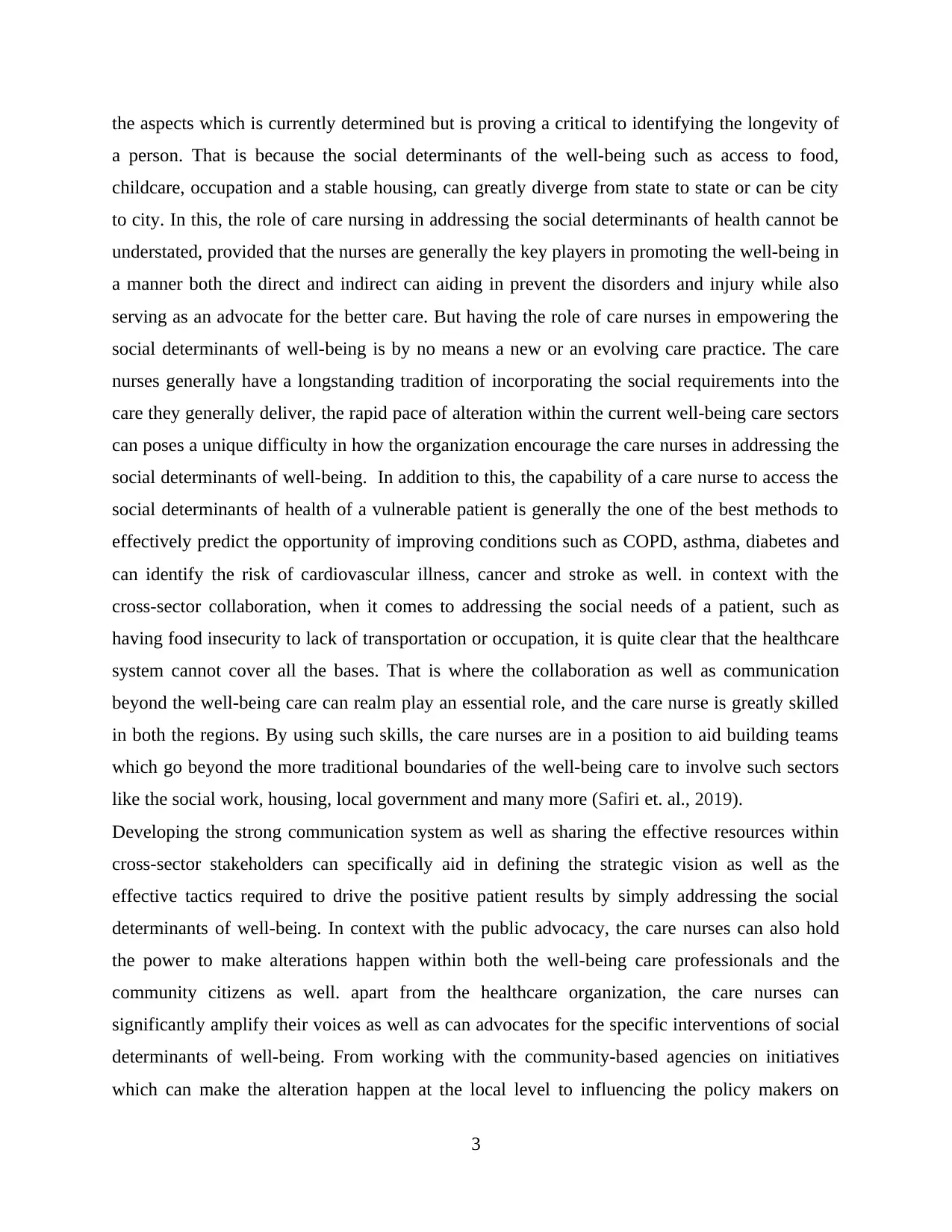
the aspects which is currently determined but is proving a critical to identifying the longevity of
a person. That is because the social determinants of the well-being such as access to food,
childcare, occupation and a stable housing, can greatly diverge from state to state or can be city
to city. In this, the role of care nursing in addressing the social determinants of health cannot be
understated, provided that the nurses are generally the key players in promoting the well-being in
a manner both the direct and indirect can aiding in prevent the disorders and injury while also
serving as an advocate for the better care. But having the role of care nurses in empowering the
social determinants of well-being is by no means a new or an evolving care practice. The care
nurses generally have a longstanding tradition of incorporating the social requirements into the
care they generally deliver, the rapid pace of alteration within the current well-being care sectors
can poses a unique difficulty in how the organization encourage the care nurses in addressing the
social determinants of well-being. In addition to this, the capability of a care nurse to access the
social determinants of health of a vulnerable patient is generally the one of the best methods to
effectively predict the opportunity of improving conditions such as COPD, asthma, diabetes and
can identify the risk of cardiovascular illness, cancer and stroke as well. in context with the
cross-sector collaboration, when it comes to addressing the social needs of a patient, such as
having food insecurity to lack of transportation or occupation, it is quite clear that the healthcare
system cannot cover all the bases. That is where the collaboration as well as communication
beyond the well-being care can realm play an essential role, and the care nurse is greatly skilled
in both the regions. By using such skills, the care nurses are in a position to aid building teams
which go beyond the more traditional boundaries of the well-being care to involve such sectors
like the social work, housing, local government and many more (Safiri et. al., 2019).
Developing the strong communication system as well as sharing the effective resources within
cross-sector stakeholders can specifically aid in defining the strategic vision as well as the
effective tactics required to drive the positive patient results by simply addressing the social
determinants of well-being. In context with the public advocacy, the care nurses can also hold
the power to make alterations happen within both the well-being care professionals and the
community citizens as well. apart from the healthcare organization, the care nurses can
significantly amplify their voices as well as can advocates for the specific interventions of social
determinants of well-being. From working with the community-based agencies on initiatives
which can make the alteration happen at the local level to influencing the policy makers on
3
a person. That is because the social determinants of the well-being such as access to food,
childcare, occupation and a stable housing, can greatly diverge from state to state or can be city
to city. In this, the role of care nursing in addressing the social determinants of health cannot be
understated, provided that the nurses are generally the key players in promoting the well-being in
a manner both the direct and indirect can aiding in prevent the disorders and injury while also
serving as an advocate for the better care. But having the role of care nurses in empowering the
social determinants of well-being is by no means a new or an evolving care practice. The care
nurses generally have a longstanding tradition of incorporating the social requirements into the
care they generally deliver, the rapid pace of alteration within the current well-being care sectors
can poses a unique difficulty in how the organization encourage the care nurses in addressing the
social determinants of well-being. In addition to this, the capability of a care nurse to access the
social determinants of health of a vulnerable patient is generally the one of the best methods to
effectively predict the opportunity of improving conditions such as COPD, asthma, diabetes and
can identify the risk of cardiovascular illness, cancer and stroke as well. in context with the
cross-sector collaboration, when it comes to addressing the social needs of a patient, such as
having food insecurity to lack of transportation or occupation, it is quite clear that the healthcare
system cannot cover all the bases. That is where the collaboration as well as communication
beyond the well-being care can realm play an essential role, and the care nurse is greatly skilled
in both the regions. By using such skills, the care nurses are in a position to aid building teams
which go beyond the more traditional boundaries of the well-being care to involve such sectors
like the social work, housing, local government and many more (Safiri et. al., 2019).
Developing the strong communication system as well as sharing the effective resources within
cross-sector stakeholders can specifically aid in defining the strategic vision as well as the
effective tactics required to drive the positive patient results by simply addressing the social
determinants of well-being. In context with the public advocacy, the care nurses can also hold
the power to make alterations happen within both the well-being care professionals and the
community citizens as well. apart from the healthcare organization, the care nurses can
significantly amplify their voices as well as can advocates for the specific interventions of social
determinants of well-being. From working with the community-based agencies on initiatives
which can make the alteration happen at the local level to influencing the policy makers on
3
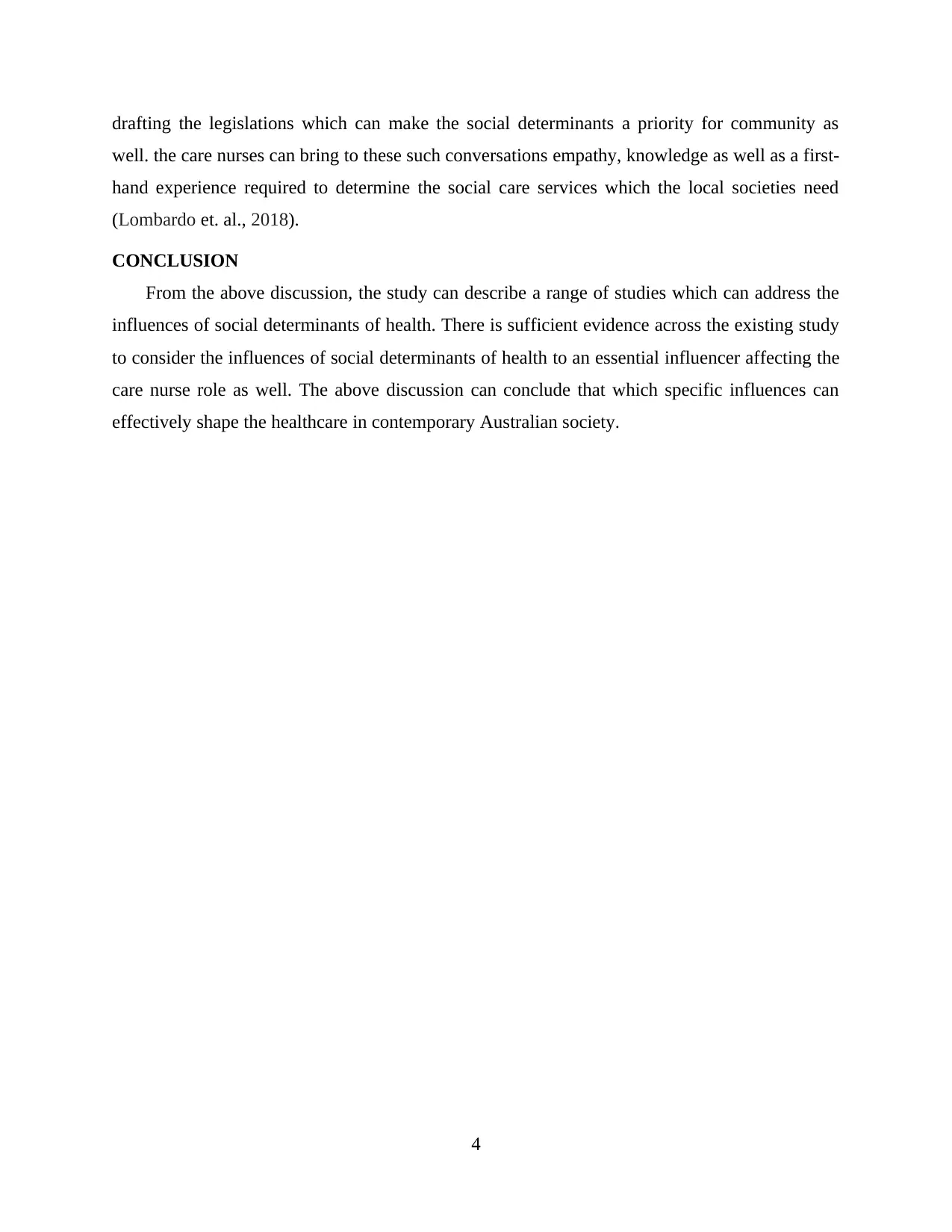
drafting the legislations which can make the social determinants a priority for community as
well. the care nurses can bring to these such conversations empathy, knowledge as well as a first-
hand experience required to determine the social care services which the local societies need
(Lombardo et. al., 2018).
CONCLUSION
From the above discussion, the study can describe a range of studies which can address the
influences of social determinants of health. There is sufficient evidence across the existing study
to consider the influences of social determinants of health to an essential influencer affecting the
care nurse role as well. The above discussion can conclude that which specific influences can
effectively shape the healthcare in contemporary Australian society.
4
well. the care nurses can bring to these such conversations empathy, knowledge as well as a first-
hand experience required to determine the social care services which the local societies need
(Lombardo et. al., 2018).
CONCLUSION
From the above discussion, the study can describe a range of studies which can address the
influences of social determinants of health. There is sufficient evidence across the existing study
to consider the influences of social determinants of health to an essential influencer affecting the
care nurse role as well. The above discussion can conclude that which specific influences can
effectively shape the healthcare in contemporary Australian society.
4
⊘ This is a preview!⊘
Do you want full access?
Subscribe today to unlock all pages.

Trusted by 1+ million students worldwide
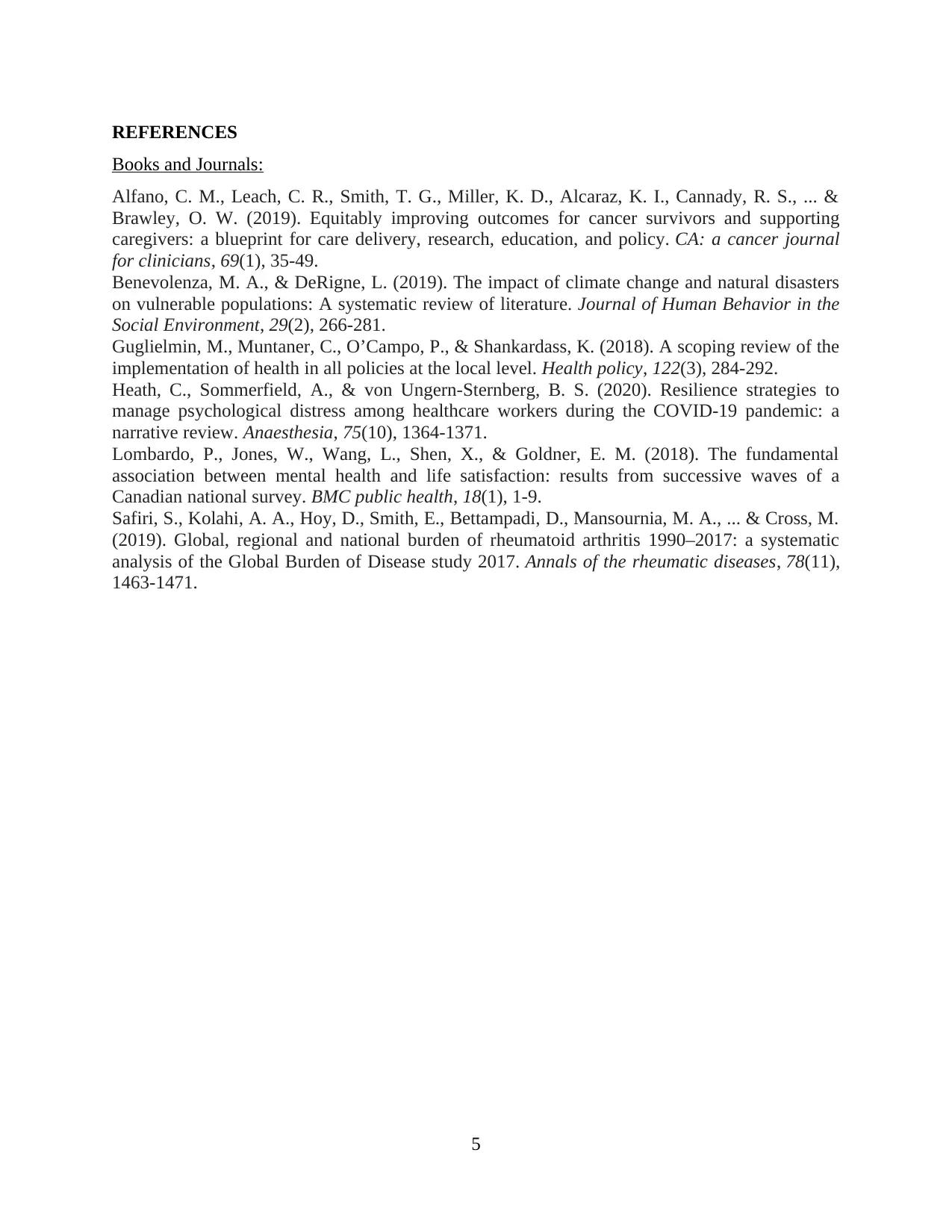
REFERENCES
Books and Journals:
Alfano, C. M., Leach, C. R., Smith, T. G., Miller, K. D., Alcaraz, K. I., Cannady, R. S., ... &
Brawley, O. W. (2019). Equitably improving outcomes for cancer survivors and supporting
caregivers: a blueprint for care delivery, research, education, and policy. CA: a cancer journal
for clinicians, 69(1), 35-49.
Benevolenza, M. A., & DeRigne, L. (2019). The impact of climate change and natural disasters
on vulnerable populations: A systematic review of literature. Journal of Human Behavior in the
Social Environment, 29(2), 266-281.
Guglielmin, M., Muntaner, C., O’Campo, P., & Shankardass, K. (2018). A scoping review of the
implementation of health in all policies at the local level. Health policy, 122(3), 284-292.
Heath, C., Sommerfield, A., & von Ungern‐Sternberg, B. S. (2020). Resilience strategies to
manage psychological distress among healthcare workers during the COVID‐19 pandemic: a
narrative review. Anaesthesia, 75(10), 1364-1371.
Lombardo, P., Jones, W., Wang, L., Shen, X., & Goldner, E. M. (2018). The fundamental
association between mental health and life satisfaction: results from successive waves of a
Canadian national survey. BMC public health, 18(1), 1-9.
Safiri, S., Kolahi, A. A., Hoy, D., Smith, E., Bettampadi, D., Mansournia, M. A., ... & Cross, M.
(2019). Global, regional and national burden of rheumatoid arthritis 1990–2017: a systematic
analysis of the Global Burden of Disease study 2017. Annals of the rheumatic diseases, 78(11),
1463-1471.
5
Books and Journals:
Alfano, C. M., Leach, C. R., Smith, T. G., Miller, K. D., Alcaraz, K. I., Cannady, R. S., ... &
Brawley, O. W. (2019). Equitably improving outcomes for cancer survivors and supporting
caregivers: a blueprint for care delivery, research, education, and policy. CA: a cancer journal
for clinicians, 69(1), 35-49.
Benevolenza, M. A., & DeRigne, L. (2019). The impact of climate change and natural disasters
on vulnerable populations: A systematic review of literature. Journal of Human Behavior in the
Social Environment, 29(2), 266-281.
Guglielmin, M., Muntaner, C., O’Campo, P., & Shankardass, K. (2018). A scoping review of the
implementation of health in all policies at the local level. Health policy, 122(3), 284-292.
Heath, C., Sommerfield, A., & von Ungern‐Sternberg, B. S. (2020). Resilience strategies to
manage psychological distress among healthcare workers during the COVID‐19 pandemic: a
narrative review. Anaesthesia, 75(10), 1364-1371.
Lombardo, P., Jones, W., Wang, L., Shen, X., & Goldner, E. M. (2018). The fundamental
association between mental health and life satisfaction: results from successive waves of a
Canadian national survey. BMC public health, 18(1), 1-9.
Safiri, S., Kolahi, A. A., Hoy, D., Smith, E., Bettampadi, D., Mansournia, M. A., ... & Cross, M.
(2019). Global, regional and national burden of rheumatoid arthritis 1990–2017: a systematic
analysis of the Global Burden of Disease study 2017. Annals of the rheumatic diseases, 78(11),
1463-1471.
5
1 out of 7
Related Documents
Your All-in-One AI-Powered Toolkit for Academic Success.
+13062052269
info@desklib.com
Available 24*7 on WhatsApp / Email
![[object Object]](/_next/static/media/star-bottom.7253800d.svg)
Unlock your academic potential
Copyright © 2020–2025 A2Z Services. All Rights Reserved. Developed and managed by ZUCOL.





